How a New Generation of Black Chefs Earned a Seat at the Table of French Haute Cuisine

When former French president François Hollande strode through the doors of red-hot Parisian restaurant Mosuke last fall and greeted chef Mory Sacko as though they were old friends, Sacko was… stunned.
Sure, the dining room had been packed every night since Sacko had become the first Black chef in Paris to earn a Michelin star—just four months after Mosuke’s September 2020 debut. Even so, when the restaurant had received a call requesting a table for two under Hollande’s name only an hour earlier, he waved it off as a prank as his team hustled to make room just in case.
More from Robb Report
Sotheby's Names a New Managing Director for Its Middle East and North African Markets
Inside This Caribbean Island's Decades-Long Saga to Become the Next Mustique
“The fact that he came in and called me by my first name was crazy,” Sacko says. “He was very curious about the culture of African gastronomy and asked me a lot of questions about the dishes and where I got my inspiration. I found that really beautiful.”
Allaying any suggestion that Hollande’s visit was a fluke, an invitation to cook for President Emmanuel Macron as part of a France-Africa summit arrived soon after. For the Franco-Malian chef, the twin presidential gestures were just two of several professional highs that have cemented his persona as an unofficial ambassador of haute African cuisine. They were also irrefutable proof that the continent’s culinary heritage is finally claiming its rightful seat at the notoriously persnickety French table.
At 29, Sacko is arguably the most popular and recognizable Black chef among the general French public today, thanks in no small part to his appearance as a contestant in the 2020 season of Top Chef in France, where the TV series is taken very seriously, and his current stint as host of the traveling cooking show Cuisine Ouverte. Along with serving up a complex Afro-French and Japanese-inspired cuisine, Mosuke challenges French palates—and perhaps a few prejudices—into accepting the foods and flavors of Mali, Senegal and Cameroon, among other countries, as significant and legitimate gastronomic experiences.
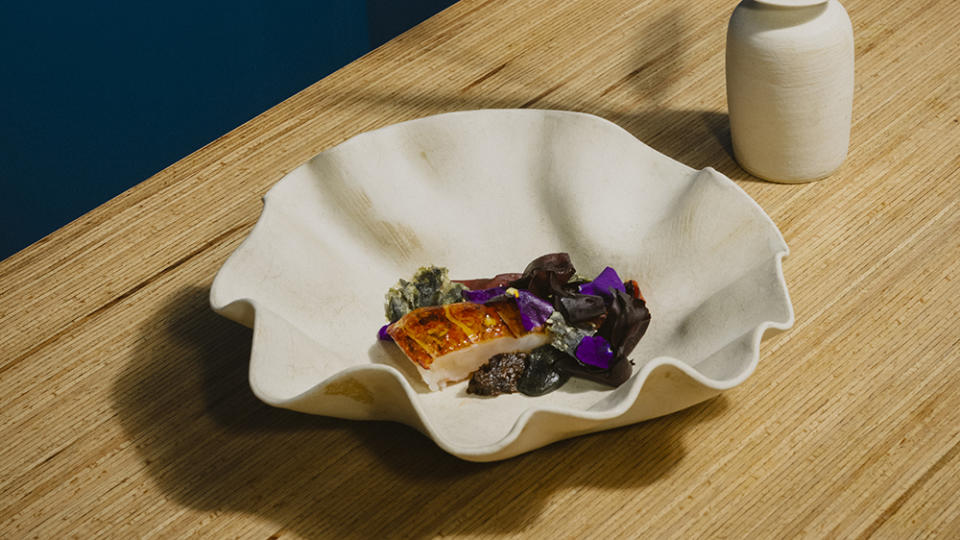
Laura Stevens
But Sacko’s accomplishments are not an isolated success story. They’re the product of a growing momentum fueled by second-generation Afro-French defying a longstanding notion held by their immigrant parents that traditional Senegalese and Malian cuisines belong in the home and have no place among the French gastronomic elite. Over the past few years, restaurants such as BMK Paris-Bamako and Le Maquis de New Soul Food and chefs including Elis Bond and Georgiana Viou have drawn serious gourmets to the richness and culinary diversity of the African continent and the French West Indies. And while it’s generally agreed that the trend is in its infancy, the new cohort of chefs and entrepreneurs are determined to make the foods and flavors of their motherlands as ubiquitous in France as sushi and ceviche are today.
Appreciating the significance of Sacko’s success in France requires a recent-history lesson about some of his predecessors. Olivier Thimothée was a pioneer when he opened Waly-Fay in the Bastille neighborhood of Paris in 1997, when he was in his mid-20s, with two friends, one of Ivorian heritage, the other French. Today, Waly-Fay is one of the longest-running African establishments in the capital and in 2019 was named one of Time Out’s 50 best restaurants in the city.
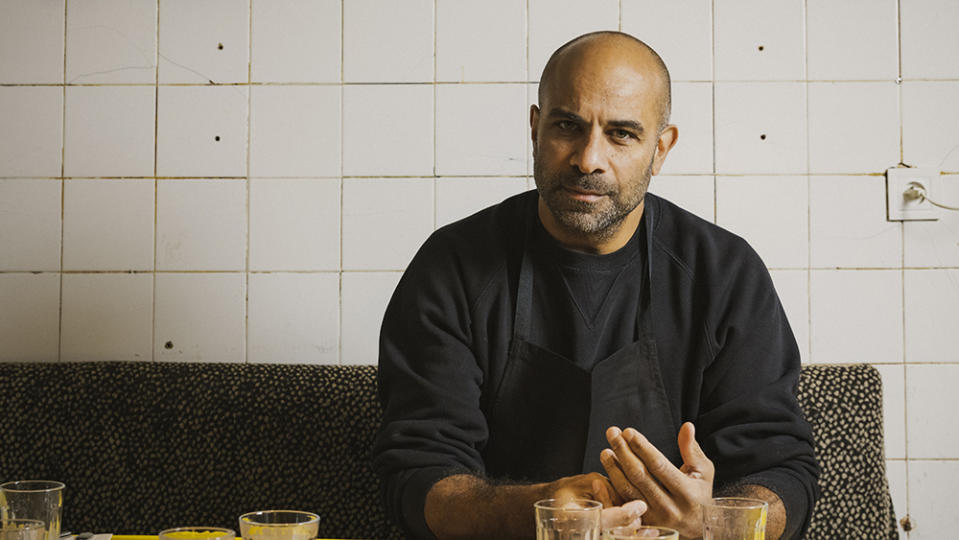
Laura Stevens
While there were plenty of mom-and-pop spots serving traditional foods for Afro-French customers, Thimothée, now 50, envisioned a space for the second generation of the African diaspora like himself (his father is from Martinique, his mother Algerian), along with local French diners. “It was our fantasy to return to our roots,” he says. “We wanted to create a place that looked like us, young people in their 20s, of various origins. Our goal was to open a good African restaurant that also had the codes of Western dining.”
That meant offering French wines alongside traditional dishes such as thie-boudienne, a Senegalese fish-and-rice platter that was recently added to the UNESCO cultural heritage list, and ndolé, a Cameroonian dish made with bitter leaves, peanuts, onions and spices.
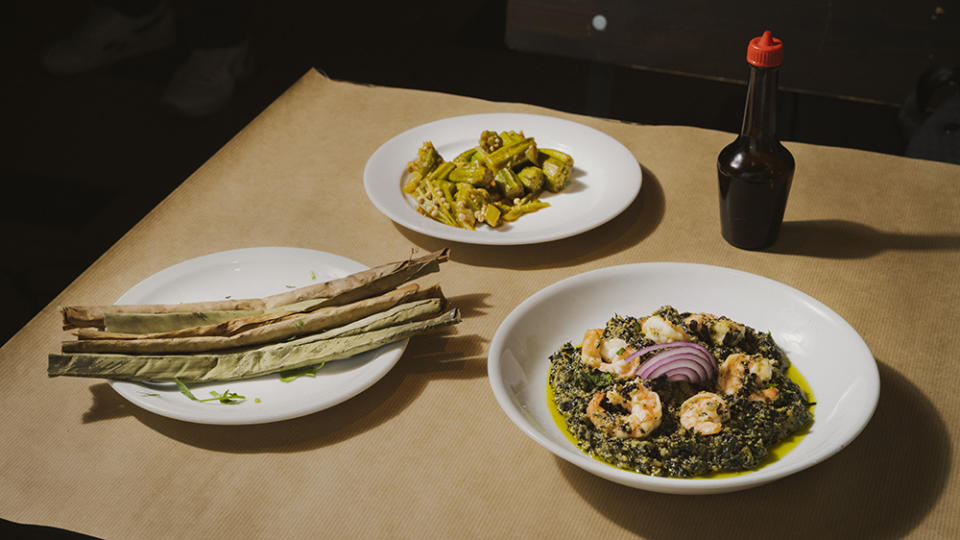
Laura Stevens
Thimothée attributes the rise of African chefs and restaurants in Paris to an influx of up-and-comers who share the same desire he had 25 years ago. “It’s a story of generations,” he says, pointing out that immigration to France from sub-Saharan Africa is a relatively recent phenomenon. Indeed, the first wave from former French colonies such as Cameroon, Ivory Coast, Mali and Senegal started in the 1960s and ’70s.
“Our parents had a hard time fitting in and struggled with their identity,” Thimothée says. “But us, we started to find our place. We were born here, went to school here, and we reinvented ourselves in France.”
Fousseyni Djikine, co-owner of BMK Paris-Bamako and BMK Folie-Bamako, which are popular among the local millennial and Gen Z crowds, echoes Thimothée’s sentiments. “The immigrant thinking after arriving in France was to not make any noise. To just do their work quietly in the corner,” says Djikine, 35, who adds that immigrants internalized ancestral trauma of colonization and saw their own cultures as less valuable than that of their adopted country. “Our parents believed that in order to be accepted, they had to make themselves small and adapt to French culture.”
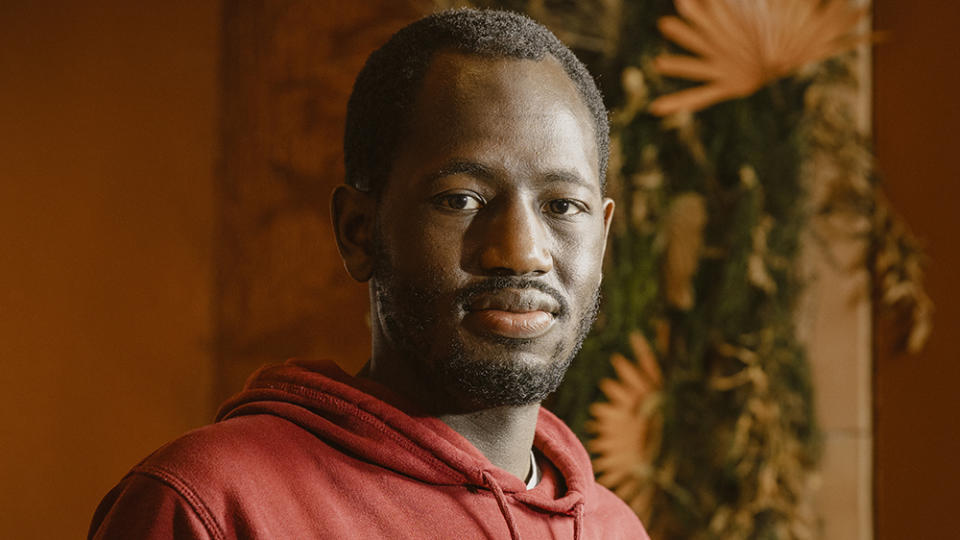
Laura Stevens
As young children, he and his brother were told to do the same. This code of conduct also applied to their foods. “We loved our Malian cuisine, but in the mind of our mother, and others like her, it was a food to be eaten at home, in private,” Djikine explains. “We never tried to highlight our cuisine because, even though it was excellent, we were taught that to integrate, it’s better to highlight French cuisine.”
And when it comes to food, there’s the undeniable fact that they live in one of the most influential gastronomic epicenters in the world. Djikine wasn’t impervious to the belief that the foods of his childhood would fail to attract Parisian diners of European descent. When he began seriously looking into opening a restaurant with his younger brother, Abdoulaye, and making their shared boyhood dream a reality, African cuisine was far from top of mind. But little by little, as Djikine, a former business consultant, began researching restaurant concepts, he realized that despite Paris boasting a sizable and dynamic diasporic community, that group’s culinary heritage was sorely underrepresented. (French law prohibits the collection of race-based data in the census, but an influx of immigrants from African and Caribbean nations has led to a substantial Black population.)
His first address, BMK Paris-Bamako in the 10th arrondissement, opened in 2017 and quickly became a local favorite, attracting the attention of Le Figaro, which included the small, casual spot in its list of top restaurants that year. Its success led to the opening of a second location in the neighboring 11th arrondissement, BMK Folie-Bamako. At both, the emphasis is on quality French ingredients—Limousin beef, free-range chicken from Normandy—and imported artisan chocolate, coffee, honey and hibiscus juice from small-scale suppliers in Africa. BMK’s signature dish, mafé, is a generous portion of smoked chicken under a blanket of creamy, unctuous peanut sauce, made from a base of homemade peanut paste.

Laura Stevens
During a Saturday-afternoon lunch service in February, every table at BMK Folie-Bamako is taken, the banquettes along the terra-cotta-painted walls occupied by young couples and groups of friends, with cushions in cheerful batik prints serving as informal dividers.
“What’s changed is, at the beginning we had people who were trying African cuisine for the first time,” Djikine says. “Now, there are fewer and fewer guests who’ve never tasted African foods, and it’s becoming more and more known.”
Chef Rudy Lainé had earned his stripes in the haute kitchens of Le Grand Véfour and Plaza Athénée when he launched his humble food truck, New Soul Food, in 2015. His strategy was to initiate Parisians to the flavors of West Africa and the West Indies with hints of the familiar. The truck’s popularity led to the 2020 opening of a brick-and-mortar restaurant, Le Maquis, along the Canal Saint-Martin in the 10th arrondissement, where yassa, a West African chicken dish traditionally made with onions and lemons, is served with attiéké (fermented cassava couscous) studded with marinated tomato confits, and the barbecued chicken aromatized with herbes de Provence, a dish he calls Afropéenne.
Inside, the atmosphere is informal and laid-back, with woven barstools surrounding big tables, wall art depicting Martin Luther King Jr. and the smell of smoky, meaty barbecue hanging heavy in the air. The restaurant has been popular from the get-go with the Black diaspora in Paris and the surrounding suburbs, who come seeking familiar comfort foods of the French West Indies and sub-Saharan Africa.
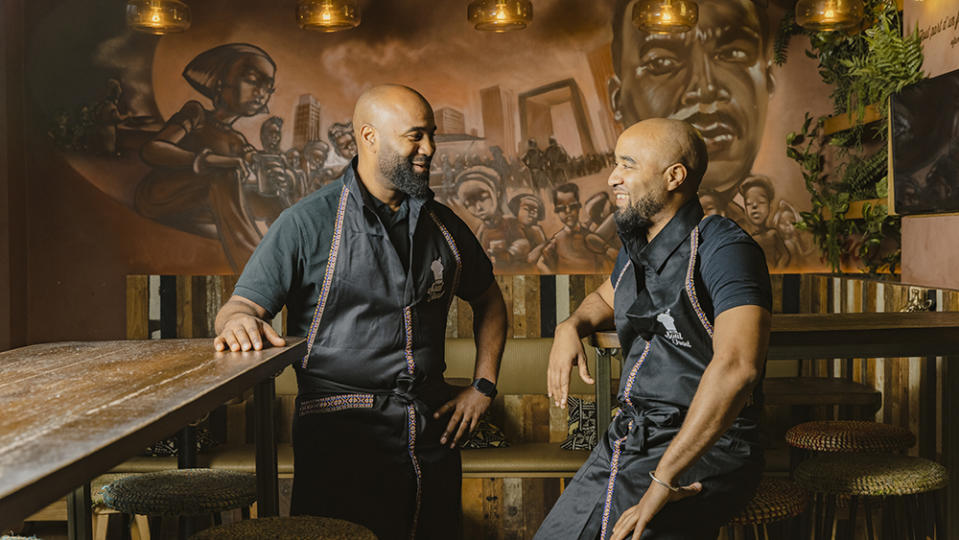
Laura Stevens
Despite his experience in some of Paris’s most elite establishments, Lainé says he never entertained the idea of opening a fancier restaurant because he doesn’t think people would slap down a lot of money for a cuisine they don’t know. Compared to diners in London, where he worked at Michel Roux’s Le Gavroche, and the US, Parisians are warier of unfamiliar tastes, in his view. “I will never do fine African dining,” he says. “It’s important to have a Mory Sacko, but it’s also important to have a bridge to that world through approachable street food.”
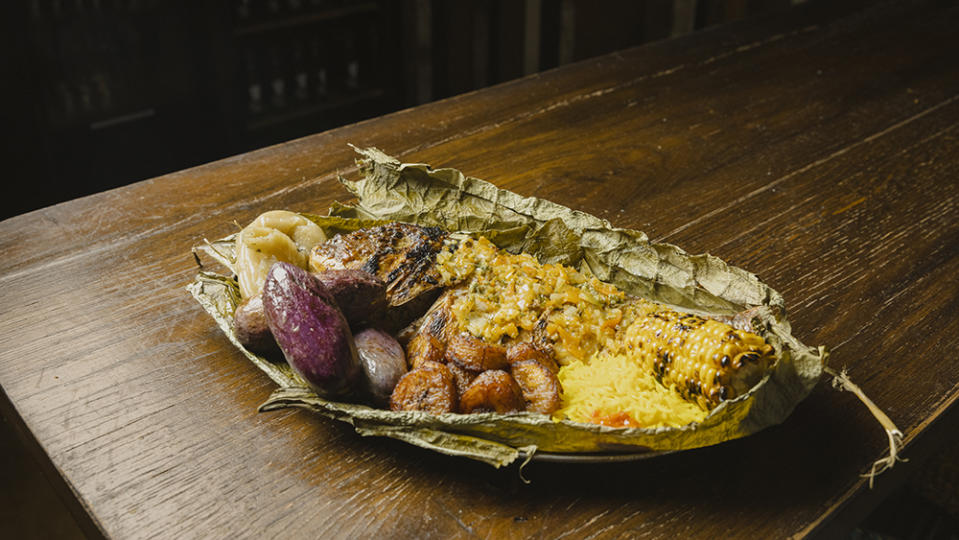
Laura Stevens
Lainé’s skepticism about customers’ attitudes is a common one. Waly-Fay’s Thimothée says the historical view of African culture as less important, less valuable, has seeped into financial considerations, with some diners—many of them African—complaining that his prices (mains are around €20, or $22) are too high. “Customers don’t mind paying €28 for a risotto or €18 for pasta,” he notes. “But an African dish, even if it’s made with fish that takes hours and hours of preparation and quality ingredients imported from Cameroon, they think it should still be cheap.”
Elis Bond, 30, knows a thing or two about devaluation. In 2019, he was named a young talent to watch by the influential French restaurant guide Gault & Millau for his work as a private chef and caterer around Paris. Despite the validation, Bond couldn’t persuade a single French bank to invest in his dream of opening a restaurant.
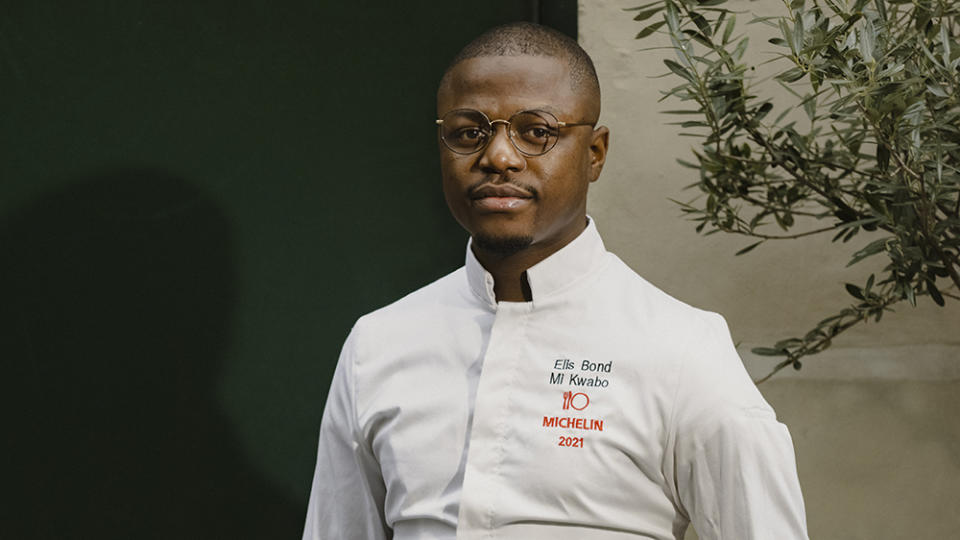
Laura Stevens
But in January 2020, Bond and his wife, Vanessa, using their savings, opened the doors to a diminutive 14-seat restaurant, Mi Kwabo, in the Pigalle neighborhood. There, the self-taught chef drew attention for elevating okra, cassava, plantains and other humble ingredients, along with traditional dishes such as fufu and mitoumba, and giving them the fine-dining treatment.
Le Figaro hailed Bond’s “creativity, finesse and sensitivity” and welcomed his departure from the repetitive rotation of yassa and mafés seen at most African restaurants in Paris. Libération also heaped praise on his refined cuisine, lauding it as a “rare offering” in the French capital.
At Mi Kwabo, mitoumba, a savory fermented-cassava and palm-oil cake popular in Cameroon, was lightly smoked in banana leaf before being fried. The end result was evocative of Parmigiano-Reggiano and smoked charcuterie meats, Bond says. The mitoumba was served with chanterelle and cèpe mushrooms, and an mbongo sauce was made from a dark spice blend from Cameroon that is charred before being ground and turns everything it touches black. Both dishes are described in the past tense because Mi Kwabo’s small size and the fallout from Covid-19 forced it to close less than two years after opening. But plans are in the works to launch a bigger, more ambitious version by September, with an expanded menu that will reflect Bond’s heritage (he was born to Haitian parents in French Guiana) and his wife’s Beninese origins, as well as their life together in France.
Like Bond, chef Georgiana Viou, who moved to France at the age of 22 from Benin, is a Gault & Millau favorite. The 2022 guide named her one of the “greats of tomorrow” in recognition of her cuisine at Rouge, in Nîmes in the South of France, after she made a name for herself with a restaurant in Marseille and as a competitor on the French version of MasterChef in 2010.
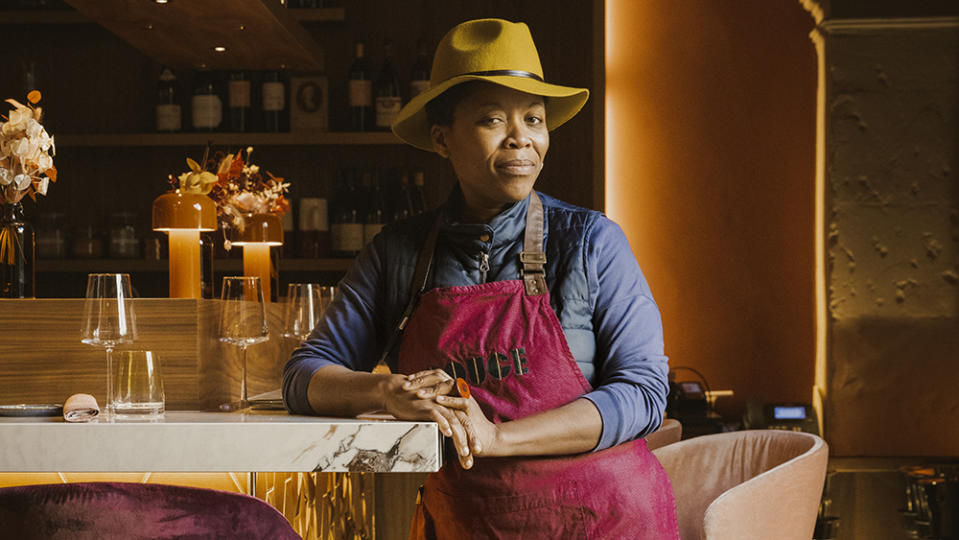
Laura Stevens
At Rouge, the 44-year-old draws inspiration from her heritage and France’s Provençale bounty to create inventive dishes such as red mullet stuffed with boudin (French blood sausage) and seasoned with mint, ginger and afitin, a traditional African mustard made from fermented néré seeds. The fish is coated in bright orange palm oil imported from small-batch producers in Benin (one of her personal campaigns is to educate the public on the difference between artisanal palm oil and the refined, industrial version), baked, then charred with a blowtorch to evoke the flavors of the barbecued fish popular in her motherland. “This dish reminds me of the flavors of home, and of my childhood,” Viou says, “and also surprises guests who’ve never known this taste before.”
The menu is local when possible and seasonal—and nothing goes to waste. Carrot fronds are dehydrated and pulverized into a powder to aromatize a dish; fish bones are fried, smoked and turned into bouillons or reduced to powder and used as fish salt. And there are days when fish, despite the restaurant’s being close to the Mediterranean coast, will not be on the menu—no apologies. “It’s up to us to educate our customers,” she says. “The sea is not a supermarket. It also has its seasons.”
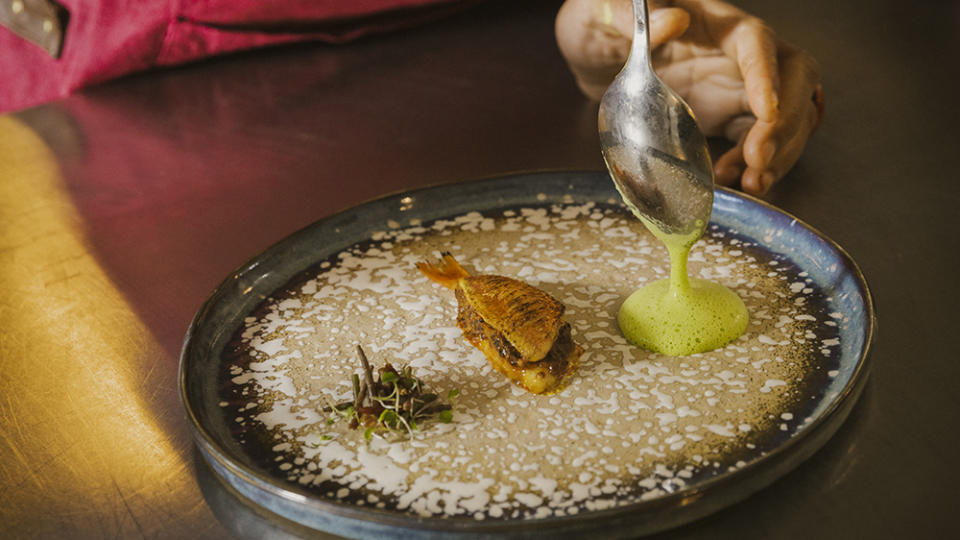
Laura Stevens
Educating the public is a common refrain. Following meals at Mi Kwabo, Bond presented diners with a platter featuring the raw forms of the ingredients they had just eaten. The BMK Paris-Bamako website offers lessons on African foods. “A lot of people know very little about the African continent,” Viou says. “First, we have to explain that our continent is made up of different regions and that, like Italy, Spain and France in Europe, things may appear to be similar but that cultures are all different.”
Indeed, there are 54 countries in Africa, each with its own traditions. It’s also worth noting that African American soul foods have established their own separate category in Paris. Restaurants such as Gumbo Yaya and Mama Jackson have gained devoted followings for their American-style comfort foods, including chicken and waffles, fried chicken, corn bread, and mac and cheese.
Back at Mosuke, Sacko’s experimental menu is already a few steps ahead and challenges diners to take a leap of faith into a culinary universe where French, African and Japanese flavors can co-exist harmoniously on a single plate. One afternoon in the empty, minimalist dining room on his day off, Sacko acknowledges the unexpected combination.
“I can see how people might have a hard time imagining a menu that’s simultaneously French, Japanese and African,” he says, relaxing with his long legs stretched out in front of his six-foot five-inch frame. “But it’s a really personal cuisine.”
It may come off as contrived on paper, but the menu’s tri-continental influences reflect Sacko’s Franco-Malian heritage and his passion for Japanese flavors that stems from a boyhood obsession with manga. He continued to cultivate that interest under the tutelage of Michelin-star chef Thierry Marx at the Mandarin Oriental, in Paris. (Mosuke is a mash-up of the chef’s first name and Yasuke, the first African samurai in Japan.)
When devising the menu, Sacko began with childhood memories of sitting around a dinner table laden with his mother’s hearty Malian and Senegalese comfort foods in the Paris suburb of Seine-et-Marne with his eight siblings. While tinkering with the recipe for her rich, creamy peanut-and-tomato-based beef mafé, he couldn’t quite put a finger on what was missing. “It wasn’t bad, but I wanted to give it something extra,” he says. His “aha” moment came when he added a few spoonfuls of umami-rich miso. Other Japanese inflections, such as yuzu in a yassa recipe, followed.
Though such innovations are what define the great chefs of any culture, Sacko and his peers are confident that today’s novelty of African cuisine will be tomorrow’s normal. “I think it’s just a matter of time,” he says. “In 20, 40 years, there won’t be anything exceptional about going to an African restaurant in Paris or elsewhere. It will happen little by little.”
Best of Robb Report
The Ultimate Guide to Wagyu Beef, the World's Most Luxurious Steak
Why a Heritage Turkey Is the Best Thanksgiving Bird—and How to Get One
The 10 Best Wines to Pair With Steak, From Cabernet to Malbec
Sign up for Robb Report's Newsletter. For the latest news, follow us on Facebook, Twitter, and Instagram.

